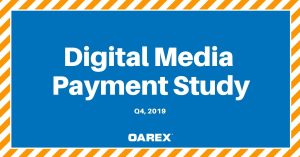 Today we released our quarterly digital media payment study, covering Q4 2019. In line with the greater industry-wide push for transparency, we began publicly disclosing our payment data in May, 2018. Since then, it has become the industry benchmark for payments, used as a go-to resource for publishers.
Today we released our quarterly digital media payment study, covering Q4 2019. In line with the greater industry-wide push for transparency, we began publicly disclosing our payment data in May, 2018. Since then, it has become the industry benchmark for payments, used as a go-to resource for publishers.
Q4, 2019 Digital Media Payment Study Overview
In Q4, we noticed certain cyclical payment trends re-emerge. The study covers 6,136 invoices we received payment on, from 211 debtors (i.e. an ad exchange that owes us money for an invoice we purchased from a publisher).
Factors Analyzed: Timing & Amount
The two biggest pain points for publishers are the wait period and the amount paid. Oftentimes, payments are late (48% of payments in December were late), and underpaid (11% were underpaid in December). A late and/or underpaid amount can have detrimental impact on a digital media firm, whose business model relies on access to readily available cash flow. Therefore we focus on these two factors:
- Timing of Payment. This inquiry asks, “How early or late does a debtor pay, relative to their stated net-terms under which the invoice should be paid?”. We call this factor the “Net Terms Differential”.
- Amount of Payment. This inquiry asks, “How much did the collected amount vary from the amount billed 30, 60 or 90 days ago?” . This inquiry takes into consideration any type of advertiser offsets (i.e. robotic traffic, fake installs) or disputes (brand awareness, sequential liability, etc.). Given that a missed payment could crush a digital media firm (especially if they have debt), we focus on this metric as the 2nd core pillar to be analyzed and refer to it as the “Paid Differential”.
Data from 6,136 invoices, 211 debtors
For this report covering October through December, 2019, we analyzed 6,136 invoices paid by 211 different digital media and advertising debtors.
Digital Media Payment Study, Q4 2019, Highlights
The Good
- The amount of late payments more than 15 days late plummeted in December to the lowest levels since February (see page 8).
- The amount of debtors by percentage paying us late half the time or less increased, which could signal firms are becoming more efficient or diligent amount payments (see page 9).
- Overall payments are stabilizing. In the last 12 months ended 12/31/2019, 72% of all payments were within 1% Paid Differential. In Q4, that was 78%. This means payment amounts are more in line with billed amounts (see page 12).
The Bad
- Late payments have been on the rise since May, 2019, peaking at 58% of all payments received in November, falling to almost half of all payments received in December being late (48% – see page 4).
- November was a bad month. The number of on-time payments (i.e. zero Time Differential) fell to an all time low (3%). Payments more than 30 days late out-number payments less than 30 days late by 2-7X (page 6).
- The percentage of payments more than 30 days late jumped 17% between Q3 and Q4 (see page 7)
- Overall payments are stabilizing but late payments remain extremely volatile – the percentage of payments a received more than 15 days late sky-rocketed to 31%, only to plummet in December (see page 8).
